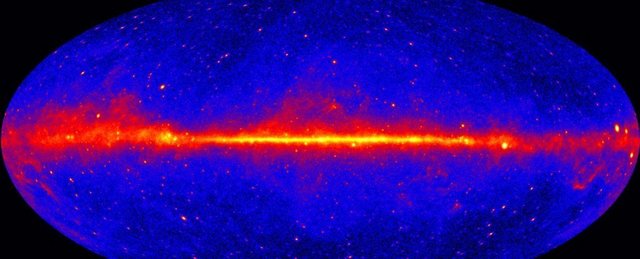Something's Glowing at The Galactic Core, And We Could Be Closer to Solving The Mystery

Something deep in the heart of the Milky Way galaxy is glowing with gamma radiation, and nobody can figure out for sure what it might be.
Colliding dark matter has been proposed, ruled out, and then tentatively reconsidered.
Dense, rapidly rotating objects called pulsars were also considered as candidate sources of the high-energy rays, before being dismissed as too few in number to make the sums work.
A study by researchers from Australia, New Zealand and Japan could breathe new life into the pulsar explanation, revealing how it might be possible to squeeze some serious intense sunshine from a population of spinning stars without breaking any rules.
Gamma radiation isn't your typical hue of sunlight. It requires some of the Universe's most energetic processes to produce. We're talking black holes colliding, matter being whipped towards light speed, antimatter combining with matter kinds of processes.
Of course, the center of the Milky Way has all of these things in spades. So when we gaze into the heavens and consider all of the crashing bits of matter, spiraling black holes, whizzing pulsars, and other astrophysical processes, we'd expect to see a healthy gamma glow.
But when researchers used NASA's Fermi telescope to measure the intense shine within the heart of our galaxy about ten years ago, they found there was more of this high-energy light than they could account for: what's known as the Galactic Centre Excess.
One exciting possibility involves unseen bits of matter bumping together in the night. These weakly interacting massive particles – a hypothetical category of dark matter commonly described as WIMPs – would cancel each other out as they smoosh together, leaving nothing but radiation to mark their presence.
It's a fun explanation to consider, but is also light on evidence.
"The nature of dark matter is entirely unknown, so any potential clues garner a lot of excitement," says astrophysicist Roland Crocker from the Australian National University.
"But our results point to another important source of gamma ray production."
That source is the millisecond pulsar.
To make one, take a star much bigger than our own and let its fires die down. It will eventually collapse into a dense ball not much wider than a city, where its atoms pack together so tightly, many of its protons are slowly baked into neutrons.
This process generates super-strong magnetic fields that channel incoming particles into fast-flowing streams glowing with radiation.
Since the object is rotating, these streams swivel around from the star's poles like the Universe's biggest lighthouse beacons – so it appears to pulse with energy. Pulsing stars that spin hundreds of times a second are known as millisecond pulsars, and we know a lot about the conditions under which they're likely to form.
"Scientists have previously detected gamma-ray emissions from individual millisecond pulsars in the neighborhood of the Solar System, so we know these objects emit gamma rays," says Crocker.
To emit them, however, they'd need a generous amount of mass to feed on. Most pulsar systems in the center of the Milky Way are thought to be too puny to emit anything more energetic than X-rays, though.
That might not always be the case, however, especially if the dead stars they emerged from are of a particular variety of ultra-massive white dwarf.
According to Crocker, if enough of these heavyweights were to turn into pulsars and hold onto their binary partners, they would provide just the right amount of gamma radiation to match observations.
"Our model demonstrates that the integrated emission from a whole population of such stars, around 100,000 in number, would produce a signal entirely compatible with the Galactic Centre Excess," says Crocker.
Being a purely theoretical model, it's an idea that now needs a generous dose of empirical evidence. Unlike suggestions based on dark matter, however, we already know exactly what to look for.
Read full news article:
https://www.sciencealert.com/a-new-spin-on-an-old-hypothesis-might-finally-explain-our-galaxy-core-s-weird-glow